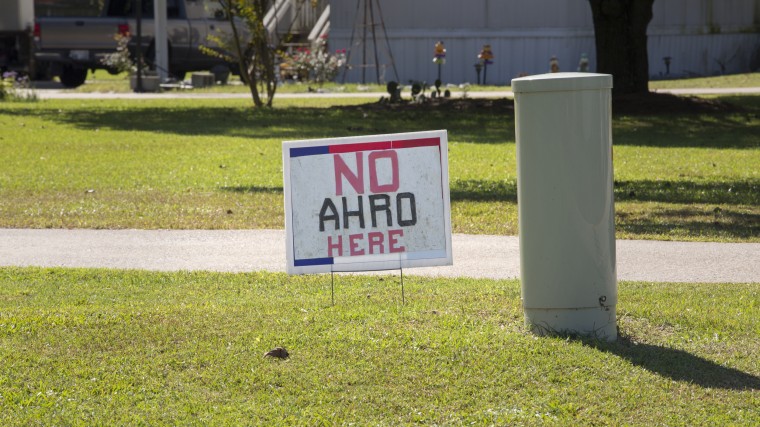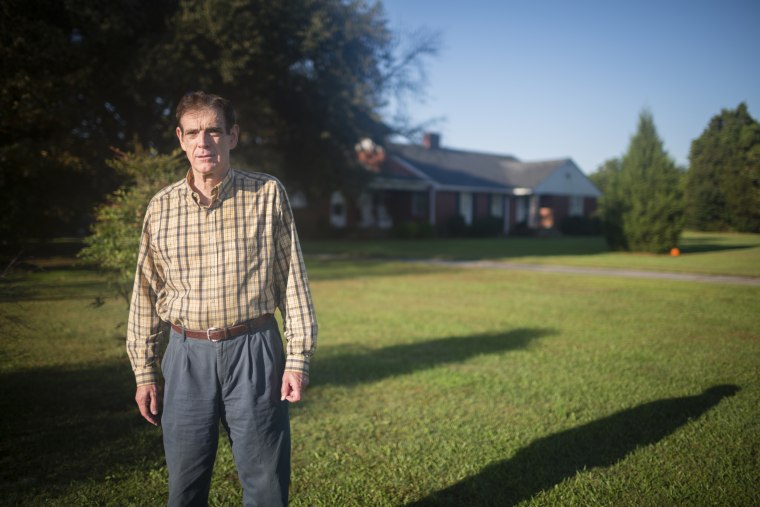Chris and Anna Smith's search for a place to build the country’s first shelter for sex-trafficked boys ended in a field in eastern North Carolina, where the wild grass and a curtain of evergreens spoke of peace and freedom.
This land, they thought, was where young survivors might escape their horrors and rebuild their lives.
"I just knew, I just knew in my soul, that this was it — that we had found the property," Anna Smith recalled.
Then the neighbors found out. In the months since the project came to light, the Smiths have been called liars, profiteers and reckless by those opposed to the shelter.
The project is nearly complete, but the backlash, in a community where time creeps and change comes slow, is emblematic of a wider struggle to crack cultural taboos that confine American male sex-trafficking victims to the shadows, where they go uncounted, misunderstood, ignored.
"There was this predominant narrative out there that this is an issue solely affecting girls. Then we found all these boys."
Children recruited into the American sex trade live on society’s margins, lured there by promises of money, shelter and attention. They’re approached at school, on the streets, in group homes and homeless shelters, online. They are, legally speaking, protected by a federal law that says anyone under 18 who is induced into commercial sex is a victim of sex trafficking. But their numbers, believed to be in the thousands, are unknown, because no one has done a thorough accounting.
Most victim-advocacy work has focused on the crime’s prevalent image: girls and young women forced into prostitution. But researchers are starting to upend that model, uncovering signs that many more boys are trapped in the illegal sex industry than previously believed.
One study, by the John Jay School of Criminal Justice, determined that nearly half of commercially exploited children in New York City were young males.
“There was this predominant narrative out there that this is an issue solely affecting girls,” project manager Meredith Dank recalled. “Then we found all these boys, and we complicated the narrative a little bit.”
Other estimates reflect a more modest proportion of male victims — as low as 3 percent. But no matter the methodology, advocates say, there are clearly a lot of boys who need help.
People who survive sex trafficking require specialized “restorative” care to recover from years of physical and emotional abuse. But they rarely seek assistance or go to police. The children among them, warped by distrust, self-blame or manipulation, often don’t even see themselves as victims.
That’s particularly true for boys.
“We live in a society where ideas about what masculinity is, what a man is, what a boy is supposed to be or become, are influenced in many ways by very toxic, distorted myths,” said Chris Anderson, CEO of Male Survivor, a support group. “And one of the most damaging ones is the idea that a man can't be a victim.”
No Place for Boys
Anderson said it took him about 20 years to tell anyone that he’d been subject to sex abuse. That’s a fairly average “disclosure delay,” he said, during which victims struggle with sexual identity, depression, anxiety and an inability to build meaningful relationships with other people.
Male victimhood “is one of the least talked about and least known areas of sexual violence and sexual exploitation,” Anderson said.
Even for girls, restorative care is hard to find. The Polaris Project, a nonprofit organization based in Washington D.C., estimates that there are only 529 shelter beds in America for victims of human trafficking — those sold for sex or for slavery.
But the survey found that only two of those beds were set aside for boys.
"Across America, boys, just like girls, are being sold for sex. And no one is talking about it.”
Chris and Anna Smith knew little of this when they set out on their journey. The couple founded their Christian ministry, Restore One, in Greenville, North Carolina in 2012, expecting to build a safe house for girls. The mission gave both an opportunity to confront their own personal trauma; Chris identifies as a survivor of abuse, and Anna says she is a survivor of sex trafficking.
Anna, 26, had interned at a girls’ shelter, seeing restorative care up close. When she told the home’s director of her plans, her former boss asked if she would consider opening a home for boys instead. The idea frightened her.
“This was the first time I had ever really pondered the idea of boys and men being harmed through sex trafficking,” Anna Smith said. “I told her that that was something I didn't want to pioneer.”
She and her husband changed their minds after they attended a talk by Tina Frundt, founder of Courtney's House and a sex trafficking survivor.
Frundt described how boys often showed up at her drop-in program, and her frustration at not being able to find them long-term care.
“It was in that moment Chris and I locked eyes,” Anna Smith recalled. “And it was an unspoken ‘Yeah,’ like, ‘We're going to do this.’ And that's when we said yes to boys.”
Their resolve hardened as they researched. “We started to learn and started to see that boys were forgotten,” Chris Smith, 27, said. “That their stories were real. That across America, boys, just like girls, are being sold for sex. And no one is talking about it.”
They set out to build the first safe home for boys who’d been sold for sex in the United States. They called it The Anchor House.

'Nature and Beauty'
After looking at several homes and building lots, the Smiths settled in 2014 on a 10-acre plot in Greene County, a soybean-and-tobacco community with 21,000 people spread across 250 square miles, where trees grow from the ruins of farm buildings and where a shuttered roadside store still has hand-painted signs advertising 5-cent bottles of Pepsi. The county touts itself as “self enduring” and “traditionally stable.”
The Smiths were attracted to the landscape, and the privacy it offered. “Part of the vision for opening Anchor House in this type of area is so the boys can find freedom in being out here in nature and beauty,” Anna Smith said.
They began construction on a house and a classroom/dining hall. Chris and Anna will not be directly involved in providing restorative care, but both plan to be involved in recreational activities with the boys, who will be between 12 and 18. Anna, a certified yoga instructor, plans to teach therapeutic yoga, and Chris plans to teach the boys to fish.
The boys — four at first, and eventually as many as 12 — will be referred by law enforcement, advocacy groups or other nonprofits, and will have to pass a mental health evaluation and drug test. The Smiths estimate it will cost $460,000 to get The Anchor House started; they’ve raised much of it from private donors.
The Smiths didn’t need any land-use approvals, so they didn’t tell the county commissioner’s office of their plans. They also registered their property under a different name to protect the boys’ privacy, they said.
“A safe home really is supposed to be more of a quiet matter, because it’s a refuge for a boy to come out of a trafficking situation where it’s dangerous,” Anna Smith said. “I had not notified the neighbors for that reason and had hoped to do so on a one-on-one manner as the home had progressed.”
The one-on-ones never took place. But word got out anyway.
Neighbors Push Back

Carson Edwards, 63, a life-long Greene County resident, said he didn’t know about the safe home until he read the local newspaper one morning. “On the front page I saw this was happening,” Edwards said.
He and other neighbors, whose ties to the land span generations, said they worried the boys would be criminals or drugs addicts. They fretted over housing values. Rumors circulated that the Smiths, who take a combined $60,000 salary from Restore One, were out to make a profit.
At the county line, someone erected a banner that read, “no sex trafficking lodge here.” Signs saying “No Restore One Anchor House Here” were posted along main roads.
Residents complained to the county board of commissioners, which passed a resolution accusing the Smiths of lying. But Restore One had done nothing illegal, so nothing could be done to stop it.

The Smiths launched a series of informational meetings for the community, where they detailed their plans. The neighbors remained skeptical; they still didn’t seem to understand where the boys would be coming from, and whether they were criminals.
Edwards said he wasn’t against the idea of helping the boys. But the Smiths’ approach soured him. “If they lied at the beginning, what lies would they tell later?” he said.
He and other residents were willing to accept the shelter being built in another part of Greene County, he said.
That is not going to happen. Construction on The Anchor House is nearly complete. The Smiths have one more license to obtain from the North Carolina Department of Social Services before they can start taking applications.
They remain committed to their vision.
“I guess it’s naïve to think that everyone would love to have a safe home for boys who have been sexually trafficked in the vicinity of their home,” Anna Smith said. “I feel like this is making history.”
People can receive help or report a tip of suspected human trafficking by calling the National Human Trafficking Resource Center (NHTRC) at 1-888-373-7888 or by sending a text to Polaris at "BeFree" (233733).

